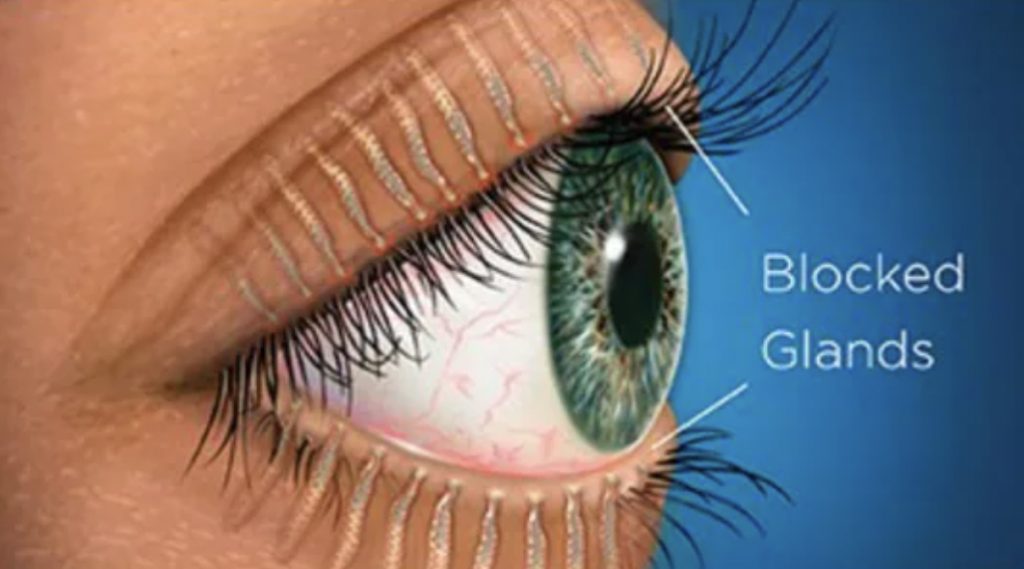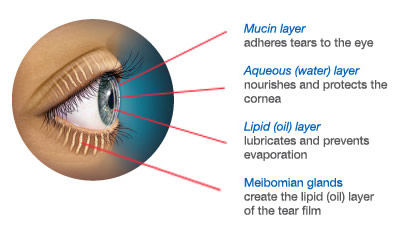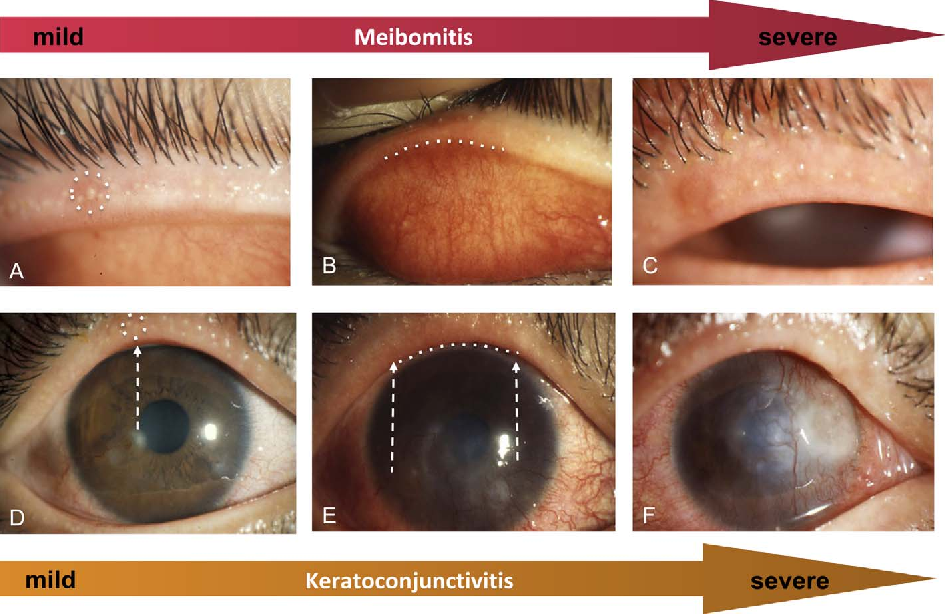
Seasonal allergies inflame the eyelids and worsen Meibomian Gland Dysfunction, blocking oil flow into the tear film. This speeds tear evaporation, intensifies dryness and irritation, and creates a cycle of allergic inflammation and MGD-driven dry eye discomfort.
Key takeaways
- Pollen and other airborne allergens increase eyelid and ocular surface inflammation, narrowing Meibomian gland openings and thickening trapped meibum.
- Reduced meibum on the tear film weakens its lipid layer, causing rapid tear evaporation and more dryness despite normal tear volume.
- Allergy symptoms itching, rubbing, redness, swelling, watering further destabilize glands and eyelid margins, amplifying MGD-related irritation.
- Management focuses on dual control: systemic or topical antihistamines plus daily warm compresses, eyelid hygiene, and lubricating drops.
- Allergen avoidance, cleaner indoor air, limited rubbing, and regular eye exams help prevent seasonal flares and protect long-term gland structure and function.
What Are Meibomian Glands and Their Role?

Meibomian glands are tiny oil-producing glands located along the edges of both the upper and lower eyelids. There are about 40 to 50 glands in the upper eyelid and around 20 to 40 in the lower eyelid. Each gland consists of clusters of cells that produce an oily substance called meibum. The primary function of these glands is to secrete meibum onto the surface of the eye, where it forms the outer lipid layer of the tear film. This lipid layer has several vital roles:
- It acts as a protective barrier that slows down evaporation of the watery part of tears, keeping the eyes moist for longer periods.
- It provides lubrication, preventing the eyelids from sticking to the eye surface when blinking.
- It helps maintain a smooth optical surface on the eye, essential for clear vision.
- It shields the eyes from environmental irritants such as dust, wind, and smoke.
When meibomian glands are healthy, they continuously produce clear, thin oil that mixes with the watery layer of tears. However, if these glands become blocked or malfunction, the meibum becomes thickened and cloudy, disrupting the tear film. This leads to faster tear evaporation, dryness, irritation, and symptoms like redness and discomfort commonly seen in dry eye and eyelid inflammation.
The effective secretion of meibum depends not only on the gland cells producing oil but also on the mechanical action of blinking, which helps express the oil onto the eye surface. Surrounding eyelid muscles contribute by compressing the glands during each blink to push the meibum outward.
Early Symptoms of Meibomian Gland Dysfunction

Meibomian Gland Dysfunction (MGD) often develops gradually, with early symptoms that can be subtle and easily overlooked. Recognizing these initial signs is essential for timely treatment and preventing progression to severe eye discomfort and damage.
- Burning or Stinging Sensation: Many people with early MGD experience a persistent burning or stinging feeling in their eyes. This sensation can worsen in dry, windy, or air-conditioned environments where tear evaporation increases. The irritation results from the tear film losing its oily layer, causing eye surfaces to dry out and become inflamed.
- Itching or Irritation: An uncomfortable itching around the eyelids is also common. This leads to a constant urge to rub or touch the eyes, but rubbing often worsens inflammation and irritation. The eyelids may feel raw or sensitive during these episodes.
- Grittiness or Foreign Body Sensation: Patients frequently report a gritty or scratchy feeling as if sand, dust, or an eyelash is stuck in their eye. This foreign body sensation is caused by dryness and inflammation of the ocular surface when meibum secretion is insufficient or abnormal.
- Watery Eyes: Paradoxically, dry eyes may cause excessive tearing as a reflex response. When the eyes become too dry, the nervous system triggers tear production to compensate. However, these tears often lack the oily layer that prevents evaporation, so watery eyes do not relieve dryness or discomfort.
- Sticky or Crusty Eyelids: Poor oil secretion leads to meibum stagnating around the eyelid margins overnight. This causes eyelids to feel sticky or matted upon waking, with crusty debris accumulating along the lashes. This symptom signals the beginning of gland blockage and inflammation.
Progression to Advanced Symptoms of Meibomian Gland Dysfunction

Meibomian Gland Dysfunction (MGD) is a progressive condition, meaning symptoms tend to worsen over time without proper intervention. As MGD advances, patients experience more intense discomfort and symptoms that interfere with daily activities and vision. Understanding these worsening symptoms helps in recognizing the need for timely treatment.
- Eyelid Redness and Swelling: The edges of the eyelids become visibly inflamed, turning red and swollen. This inflammation can cause tenderness and persistent discomfort. The eyelid margins may become rough and irritated from chronic exposure to inflammation and damage.
- Eyelid Margin Irregularities: In advanced MGD, the eyelid margins undergo changes such as thickening and roughening. Small blood vessels near the surface (called telangiectasia) become visible, giving the eyelid edges a red, flushed appearance. The gland openings may appear blocked or clogged with thickened secretions.
- Blurred or Fluctuating Vision: Due to tear film instability, vision often becomes blurry or fluctuates throughout the day. Blinking can temporarily restore clarity as it spreads the tear film evenly across the eye, but the effect is short-lived with unstable tears. These vision changes can affect reading, driving, and screen use.
- Sensitivity to Light: Also known as photophobia, this occurs as the inflamed and dry ocular surface becomes more sensitive to bright lights, sunlight, or digital screen glare. Patients may find it uncomfortable to be outdoors or in brightly lit environments.
- Difficulty Wearing Contact Lenses: Many people with advanced MGD find wearing contact lenses uncomfortable or intolerable. Dryness and irritation worsen under lenses, leading to redness, burning, and a feeling of having something stuck in the eye. This often disrupts lens use and may require switching to glasses.
- Recurrent Eyelid Infections or Styes: Blocked and dysfunctional Meibomian glands increase the risk of bacterial infections along the eyelid margins. This can result in the formation of styes or chalazia, which are painful, swollen lumps caused by infected or clogged glands. These infections can be recurrent and further worsen MGD symptoms.
Causes of Meibomian Gland Dysfunction (MGD)
Here is an explanation of the causes of Meibomian Gland Dysfunction (MGD):
- Aging: As people age, the meibomian glands undergo cell degeneration and atrophy, leading to decreased lipid production that is essential for maintaining a healthy tear film.
- Hormonal changes: Androgen deficiency, especially during menopause or due to certain hormone therapies, reduces stimulation of the glands, causing lower quality and quantity of oil secretion and increased inflammation.
- Environmental factors: Exposure to low humidity, pollution, smoke, and allergens can irritate the eyes and eyelids, leading to inflammation that blocks the glands.
- Prolonged screen time: Decreased blinking frequency during extended use of screens allows tear evaporation and oil stagnation, worsening gland function.
- Contact lens use: Mechanical irritation and chronic inflammation from lenses can cause obstruction and damage to the glands, potentially leading to gland dropout.
- Medications: Some systemic and topical drugs like isotretinoin, β-blockers, glaucoma treatments, and hormone replacement therapies adversely affect gland structure and function.
- Underlying medical conditions: Autoimmune diseases (e.g., Sjogren’s syndrome), skin disorders (rosacea, psoriasis), and chronic blepharitis cause inflammation and obstruct gland ducts.
- Poor eyelid hygiene: Accumulated bacteria, debris, or improper eye makeup removal can clog gland openings, resulting in dysfunction.
- Microbial factors: Infestation by Demodex mites and bacterial overgrowth on eyelid margins release enzymes and toxins that irritate glands.
- Physical damage: Trauma or injury to the eyelids or cornea can impair gland function.
- Genetic or congenital factors: Some individuals have fewer glands or congenital abnormalities affecting gland secretion and health.
Impact of Environmental and Lifestyle Factors on Meibomian Gland Dysfunction Symptoms
The symptoms of Meibomian Gland Dysfunction (MGD) can be influenced and worsened by several environmental and lifestyle factors. Understanding these triggers helps manage and reduce symptom severity effectively.
- Prolonged Screen Use: Spending long hours in front of digital screens reduces the natural blinking rate. Blinking is essential for spreading the oily secretion from Meibomian glands evenly across the eyes. Reduced blinking leads to inadequate lubrication and faster tear evaporation, worsening dryness and irritation.
- Exposure to Air Conditioning, Heating, Smoke, or Dry Air: Indoor environments with air conditioning or heating often have very low humidity, accelerating tear evaporation. Similarly, exposure to smoke, pollution, or wind irritates the eyes and promotes inflammation. Dry, polluted air stresses the ocular surface and worsens MGD symptoms by destabilizing the tear film.
- Contact Lens Wear: Wearing contact lenses can increase dryness and irritation in people with MGD. Lenses may interfere with tear film distribution and exacerbate the imbalance between tear evaporation and production. This often results in discomfort, redness, and difficulty tolerating lenses over time.
- Seasonal Allergies and Allergen Exposure: During allergy seasons, airborne allergens such as pollen can cause inflammation of the eyes and eyelids. This inflammation affects the Meibomian glands by causing swelling and blockage, which reduces their ability to secrete the oil (meibum) needed to keep the eyes lubricated. Allergic reactions also increase itching, redness, and irritation around the eyes, further worsening symptoms of Meibomian Gland Dysfunction. This combination leads to a cycle of discomfort and dryness that can be challenging to manage without proper treatment.
Preventive measures for Meibomian Gland Dysfunction
Preventive measures for Meibomian Gland Dysfunction include maintaining eyelid hygiene, applying warm compresses regularly, taking omega-3 supplements, limiting screen time with frequent blinking, avoiding smoking, staying hydrated, and using lubricating eye drops to keep the glands functioning properly.
- Maintain regular eyelid hygiene by cleaning lids and lashes with mild soap or baby shampoo.
- Apply warm compresses to eyelids daily to help unclog glands and improve oil flow.
- Perform gentle eyelid massage to assist in gland expression.
- Take oral omega-3 fatty acid supplements to improve meibum quality and reduce inflammation.
- Limit screen time and practice frequent blinking to keep eyes lubricated.
- Avoid smoking, which can worsen gland dysfunction.
- Stay hydrated and use artificial tears or lubricating eye drops to prevent dryness.
- Schedule regular eye exams for early detection and management of any gland issues.
Conclusion
Seasonal allergies cause eye inflammation that blocks Meibomian glands, reducing oil secretion important for tear stability. This results in faster tear evaporation, dry eyes, itching, and redness, worsening symptoms of Meibomian Gland Dysfunction. Many with allergies face increased discomfort during pollen seasons. Allergy management, including medication and eyelid care, helps maintain gland function and eye comfort. Recognizing how allergens impact MGD guides better treatment and relief strategies.
FAQs
What are the early symptoms of Meibomian Gland Dysfunction?
Early symptoms of MGD can be subtle and often go unnoticed at first. Common initial signs include a persistent burning or stinging sensation in the eyes, especially in dry, windy, or air-conditioned environments. Patients may also feel itching or irritation around the eyelids, leading to frequent rubbing. A gritty or foreign body sensation, as if sand or dust is in the eyes, is typical due to tear film instability from poor lipid secretion. Watery eyes may paradoxically occur as a reflex response to dryness, and sticky or crusty eyelids on waking are often early clues of gland dysfunction and blocked oil secretion.
How does MGD cause dry eye symptoms?
Meibomian glands produce the oily layer of the tear film that slows tear evaporation and keeps the eyes lubricated. When these glands are blocked or their oil secretion thickens and becomes ineffective, the tear film becomes unstable. Without enough oil, tears evaporate quickly, leading to dryness, redness, burning, and irritation typical of dry eye syndrome. The unstable tear film also allows for increased exposure to environmental irritants, exacerbating symptoms.
Can MGD affect vision?
Yes, MGD can cause blurred or fluctuating vision. This occurs because the tear film, which acts as a smooth optical surface, becomes unstable when the oily layer is insufficient. As the tear film breaks up quickly, vision clarity diminishes intermittently. Blinking briefly restores the tear film, temporarily clearing vision, but symptoms usually return. This fluctuation can interfere with reading, driving, and screen use.
Why do my eyelids look red and swollen with MGD?
Chronic inflammation caused by obstructed and dysfunctional glands leads to red, swollen, and tender eyelid margins. The eyelid edges may become thickened and roughened with visible small blood vessels termed telangiectasia. These changes result from ongoing irritation and disrupted tear film protection, which inflames the delicate eyelid skin and gland openings.
Is itching a common symptom of MGD?
Yes, itching around the eyelids is a common symptom resulting from irritation of the ocular surface and lids. This ongoing itchiness can prompt frequent eye rubbing, which exacerbates inflammation and can worsen gland blockage, creating a vicious cycle of symptoms.
Can MGD symptoms worsen with allergies?
Seasonal allergies cause eye and eyelid inflammation, which can further block Meibomian glands, reducing meibum secretion. Allergic reactions increase symptoms such as itching, redness, and tearing, compounding discomfort and dryness caused by MGD. The combination of allergies and MGD creates more persistent and severe symptoms, especially during pollen seasons.
Why do I sometimes have watery eyes if I have MGD?
Despite feeling dry, eyes may produce excessive watery tears as a reflex response to irritation and dryness. These tears often lack the oily protection from meibum, so they evaporate quickly and fail to relieve dryness, resulting in a confusing mix of watering yet irritated eyes.
Can wearing contact lenses worsen MGD symptoms?
Wearing contact lenses can aggravate MGD symptoms by interfering with tear film distribution and increasing tear evaporation. This often leads to more pronounced dryness, redness, and discomfort, sometimes causing users to reduce wear time or switch to glasses.
What are signs of advanced MGD?
Advanced MGD is characterized by persistent redness, thickened and rough eyelid margins, visible telangiectasia, frequent eyelid infections, styes or chalazia, and significant dry eye symptoms. Vision disturbances and sensitivity to light also intensify. If untreated, gland atrophy and permanent tear film damage can occur.
When should I see an eye doctor for MGD symptoms?
If symptoms like burning, redness, dryness, or vision fluctuations persist for more than a few weeks or affect daily activities, professional evaluation is recommended. Early diagnosis helps prevent progression to severe symptoms and complications.
Reference
- Cleveland Clinic. Meibomian Gland Dysfunction: Symptoms & Treatment.
https://my.clevelandclinic.org/health/diseases/meibomian-gland-dysfunction - WebMD. What Is Meibomian Gland Dysfunction?
https://www.webmd.com/eye-health/meibomian-gland-dysfunction - National Center for Biotechnology Information (NCBI). Meibomian Gland Disease – StatPearls.
https://www.ncbi.nlm.nih.gov/books/NBK580474/ - American Association for Pediatric Ophthalmology and Strabismus (AAPOS). Meibomian Gland Dysfunction and Treatment.
https://aapos.org/glossary/meibomian-gland-dysfunction-and-treatment - Stoney Creek Eye Care. Meibomian Gland Dysfunction: Symptoms, Diagnosis, & Treatment.
https://stoneycreekeyecare.com/meibomian-gland-dysfunction-symptoms-diagnosis-treatment/ - Bangok Hospital. Meibomian gland dysfunction (MGD), one of contributing causes of dry eye disease.
https://www.bangkokhospital.com/en/bangkok/content/meibomian-gland-dysfunction
Aubrey Carson is an RDN with 9 years across hospital, outpatient, and private practice settings. They earned an MS in Clinical Nutrition from Tufts University – Friedman School (2016) and completed a Dietetic Internship at Mayo Clinic. Aubrey specializes in micronutrient assessment, evidence-based supplementation, and patient education. Their work includes CE presentations for the Academy of Nutrition and Dietetics and collaborations with Mass General Brigham on nutrition education resources.

